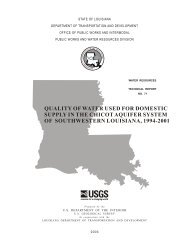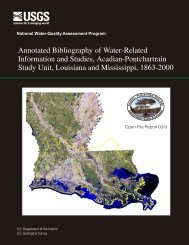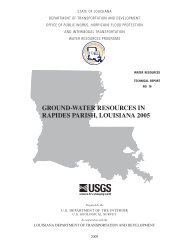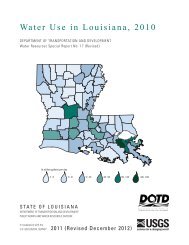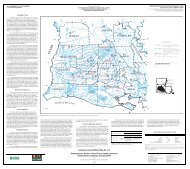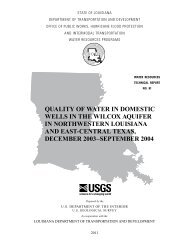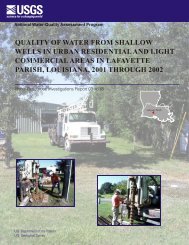environmental setting, water quality, and ecological indicators of
environmental setting, water quality, and ecological indicators of
environmental setting, water quality, and ecological indicators of
You also want an ePaper? Increase the reach of your titles
YUMPU automatically turns print PDFs into web optimized ePapers that Google loves.
habitat conditions associated with drainage area than by<br />
conditions associated with agricultural intensity.<br />
The abundance-weighted tolerance (biotic index)<br />
results were consistent with composition metrics results<br />
<strong>and</strong> indicated most tolerant organisms occurred at highintensity<br />
sites, mainly the large high-intensity sites<br />
(table 9). The abundance-weighted values were calculated<br />
by weighting the tolerance value by the abundance<br />
<strong>of</strong> the organism in the sample. Tolerance values were<br />
based on a scale from 0 to 10, where 0 represented the<br />
tolerance value <strong>of</strong> an extremely sensitive organism <strong>and</strong><br />
10 represented the value for a tolerant organism. Thus,<br />
a higher abundance-weighted tolerance value indicated<br />
that the communities at these sites were composed <strong>of</strong><br />
more organisms considered tolerant to many types <strong>of</strong><br />
stress associated with stream disturbance. Median abundance-weighted<br />
tolerance was greater at the high-intensity<br />
sites (7.11) than at the low-intensity sites (6.18).<br />
Canonical Correspondence Analysis Site<br />
Groups<br />
For this report, CCA (ter Braak <strong>and</strong> Smilauer, 1998)<br />
was used to evaluate patterns among sites based on the<br />
relative abundance <strong>of</strong> aquatic invertebrates <strong>and</strong> <strong>environmental</strong><br />
variables. The CCA <strong>and</strong> the forward selection<br />
process reduced 36 <strong>environmental</strong> variables to 4 that best<br />
described the relations among <strong>water</strong> <strong>quality</strong>, habitat, <strong>and</strong><br />
invertebrate communities among sites. The CCA identified<br />
four significant (p ≤ 0.05) <strong>environmental</strong> variables<br />
(instream cover score, percentage <strong>of</strong> open canopy, concentrations<br />
<strong>of</strong> dissolved oxygen, <strong>and</strong> maximum concentration<br />
<strong>of</strong> dissolved fipronil) that described the distribution<br />
<strong>of</strong> aquatic invertebrate communities among <strong>ecological</strong><br />
data-collection sites (fig. 16). The first CCA axis<br />
represents the dissolved oxygen <strong>and</strong> open canopy gradient,<br />
<strong>and</strong> the second CCA axis represents the instream<br />
cover <strong>and</strong> fipronil concentration gradient. The labeled<br />
34<br />
arrows (vectors) in the CCA biplot indicate spatial associations<br />
<strong>of</strong> site <strong>and</strong> species scores with <strong>environmental</strong><br />
variables. The value <strong>of</strong> the <strong>environmental</strong> variable<br />
increases in the direction the vector points. The length <strong>of</strong><br />
the vector reflects the importance <strong>of</strong> the <strong>environmental</strong><br />
variable in the CCA model. Vectors parallel to an axis<br />
are highly correlated with that axis <strong>and</strong> vectors perpendicular<br />
to an axis are poorly correlated with that axis<br />
(table 10).<br />
Cluster analysis using site scores from the first two<br />
CCA axes (Wilkinson <strong>and</strong> others, 1998) identified four<br />
site groups (A, B, C, <strong>and</strong> D) that had similar <strong>water</strong> <strong>quality</strong>,<br />
habitat, <strong>and</strong> aquatic invertebrate characteristics.<br />
These site groups were geographically separated within<br />
the study (fig. 17). Group A included 2 sites in the northern<br />
part <strong>of</strong> the Mermentau River Basin <strong>and</strong> 1 site in the<br />
adjacent Calcasieu River Basin. Other sites, all in the<br />
Mermentau River Basin, were grouped as follows: 4 sites<br />
in the southeastern part <strong>of</strong> the basin (group B), 6 sites in<br />
the north-central <strong>and</strong> southeastern parts (group C), <strong>and</strong> 6<br />
in the south-central <strong>and</strong> southwestern parts (group D).<br />
Discriminate analysis (Engelman, 1998) showed statistical<br />
significance (Wilk’s lambda = 0.014, p ≤ 0.001) <strong>of</strong><br />
cluster analysis site group assignments with 89 percent<br />
<strong>of</strong> sites correctly classified to CCA site groups.<br />
Figure 16 shows the distribution <strong>of</strong> <strong>ecological</strong> datacollection<br />
sites <strong>and</strong> site groups in relation to CCA <strong>environmental</strong><br />
variables. The highest instream cover <strong>and</strong><br />
smallest fipronil concentrations were present at sites in<br />
group A. Sites in group B were characterized by moderate<br />
instream cover, open canopy, <strong>and</strong> dissolved oxygen<br />
concentrations, <strong>and</strong> small fipronil concentrations. Group<br />
C sites were characterized by large dissolved-oxygen <strong>and</strong><br />
fipronil concentrations. The largest amount <strong>of</strong> open canopy<br />
<strong>and</strong> the smallest dissolved-oxygen concentrations<br />
were present at sites in group D. Figure 16 also shows<br />
the CCA distribution <strong>of</strong> relative abundances <strong>of</strong> aquatic<br />
Table 10. Canonical correlation coefficients <strong>of</strong> <strong>environmental</strong> variables with the first four canonical correspondence<br />
analysis axes for aquatic invertebrates at <strong>ecological</strong> data-collection sites in southwestern Louisiana, 2001<br />
[Numbers in parentheses are eigenvalues]<br />
Canonical correspondence analysis model<br />
<strong>environmental</strong> variables<br />
Axis 1<br />
(0.31)<br />
Axis 2<br />
(0.18)<br />
Axis 3<br />
(0.16)<br />
Axis 4<br />
(0.09)<br />
Open canopy 0.67 0.16 0.14 0.80<br />
Instream cover - .21 .32 - .80 .56<br />
Dissolved oxygen - .64 - .51 .14 .69<br />
Dissolved fipronil (maximum) < .01 - .96 - .53 - .07<br />
Cumulative percent <strong>of</strong> species variance explained 16.0 25.4 33.6 38.4<br />
Cumulative percent <strong>of</strong> species-environment variance explained 41.8 66.2 87.4 100



